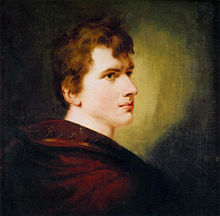Angelika, the Genoese, and Cosmus, the rope jumper
Angelika, the Genoese, and Cosmus, the rope jumper is a novella by Achim von Arnim that appeared in the so-called collection of novels from 1812 in the Realschulbuchhandlung Berlin.
content
Second half of the 18th century: After the death of her unloved husband, Countess Angelika from Genoa travels to Germany with her beautiful young niece Marianina. The Italian is looking for her illegitimate son Cosmus and finds the beloved boy in Heidelberg , as he pursues the breakneck profession of a rope jumper in the wake of the unscrupulous Mr. Hitzler. Angelika doesn’t reveal herself to her son, but Cosmus suspects who he has in front of him: that adored, beloved mother whom he had longingly sought for years - wandering all over Europe - without success.
In a letter, Cosmus tells his mother about his life. He grew up in Bavaria on the border with Tyrol in the house of the forester Rost. At the age of seven, the boy found out from the forester that his father - Cosmus called him Friedrich - had fallen victim to a robbery in Italy. At the age of fifteen Cosmus met the noble Countess Filomena as a choir student in Regensburg and Passau , who probably wanted him. Her husband, the hated Italian count, introduced Cosmus as an excellent young singer to the local society. On the following year-long search for his mother, the now twenty-one year old ended up in Algiers .
After reading the above letter, the mother still does not reveal herself to the son. Rather, she tells Cosmus her story in which she poses as his aunt and reports about her alleged sister. Cosmus is the son of Winckelmann . The esthete was during the lifetime of the teacher of Angelika's father, the Marchese Solar. The Marchese betrothed the daughter to the rich Count Filomena. The forester Rost, with whom Winckelmann had deposited his art collection, carried out the above-mentioned murder on behalf of the treacherous count. Angelika lived a joyless marriage with Filomena. In Regensburg and Passau Filomena tried in vain to have the " banker " Cosmus killed. Angelika can no longer hold out her tale of lies about her aunt and confesses: “Yes, my dear son, it's me, your mother.” Cosmus leaves her mother in Heidelberg and leads a robber life under that Hitzler in the Odenwald . The unfortunate villain Förster Rost alias Mr. Hitzler is punished with death by the Heidelberg chief judge for his crimes. Cosmus, also officially declared innocent by Angelika's energetic assistance, triumphs. The former rope skipper and the young Marianina become a couple.
Quote
- "The joys are so true and only the worries lie."
reception
- Kratzsch criticizes the narrator's slipping into the genre robber novel towards the end of the text.
- Arnim deal with autobiographical issues: Moering addresses the author's self-mockery as a tightrope walker.
- Dorothea Nolde : "Stories from the run-up to a 'time of women': Achim von Arnim's cycle of novels from 1812" . P. 47ff. GRIN Verlag, November 2007, ISBN 3-638-86107-4
literature
- Helene M. Kastinger Riley : Achim von Arnim . rowohlt's monographs edited by Kurt Kusenberg . 158 pages. Reinbek near Hamburg in July 1979, ISBN 3-499-50277-1
- Renate Moering (Ed.): Achim von Arnim. All the stories 1802–1817. Vol. 3 in: Roswitha Burwick (Hrsg.), Jürgen Knaack (Hrsg.), Paul Michael Lützeler (Hrsg.), Renate Moering (Hrsg.), Ulfert Ricklefs (Hrsg.), Hermann F. Weiss (Hrsg.): Achim von Arnim. Works in six volumes. 1398 pages. Deutscher Klassiker Verlag Frankfurt am Main 1990 (1st edition), ISBN 3-618-60030-5
Quoted text edition
- Achim von Arnim: Angelika, the Genoese, and Cosmus, the rope jumper. A novella . Pp. 211–268 in Konrad Kratzsch (ed.): Achim von Arnim: Erzählungen. 635 pages. Aufbau-Verlag Berlin and Weimar 1968 (1st edition)
Web links
- The text at Gutenberg-DE
Individual evidence
Source means the quoted text edition
- ^ Riley, p. 136, entry from 1812
- ↑ Information on the history of the edition can be found in Moering, pp. 1263–1266. The collection of novels from 1812 still contains: Melück Maria Blainville , Isabella of Egypt and The Three Loving Sisters and the Happy Dyer .
- ↑ On the historical truth: The convicted Winckelmann murderer is not an Upper Bavarian forester, but Francesco Arcangeli .
- ↑ Source, p. 251, 14. Zvo
- ↑ Kratzsch in the afterword of the source, p. 610, 5th Zvu - p. 611 middle
- ↑ Moering, p. 1263
